任爱英语八年级全英文说课稿.pdf
- 格式:pdf
- 大小:45.60 KB
- 文档页数:4
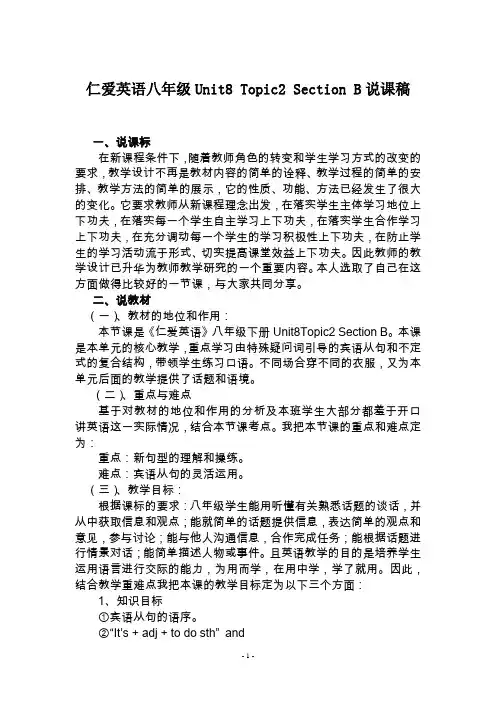
仁爱英语八年级Unit8 Topic2 Section B说课稿一、说课标在新课程条件下,随着教师角色的转变和学生学习方式的改变的要求,教学设计不再是教材内容的简单的诠释、教学过程的简单的安排、教学方法的简单的展示,它的性质、功能、方法已经发生了很大的变化。
它要求教师从新课程理念出发,在落实学生主体学习地位上下功夫,在落实每一个学生自主学习上下功夫,在落实学生合作学习上下功夫,在充分调动每一个学生的学习积极性上下功夫,在防止学生的学习活动流于形式、切实提高课堂效益上下功夫。
因此教师的教学设计已升华为教师教学研究的一个重要内容。
本人选取了自己在这方面做得比较好的一节课,与大家共同分享。
二、说教材(一)、教材的地位和作用:本节课是《仁爱英语》八年级下册Unit8Topic2 Section B。
本课是本单元的核心教学,重点学习由特殊疑问词引导的宾语从句和不定式的复合结构,带领学生练习口语。
不同场合穿不同的衣服,又为本单元后面的教学提供了话题和语境。
(二)、重点与难点基于对教材的地位和作用的分析及本班学生大部分都羞于开口讲英语这一实际情况,结合本节课考点。
我把本节课的重点和难点定为:重点:新句型的理解和操练。
难点:宾语从句的灵活运用。
(三)、教学目标:根据课标的要求:八年级学生能用听懂有关熟悉话题的谈话,并从中获取信息和观点;能就简单的话题提供信息,表达简单的观点和意见,参与讨论;能与他人沟通信息,合作完成任务;能根据话题进行情景对话;能简单描述人物或事件。
且英语教学的目的是培养学生运用语言进行交际的能力,为用而学,在用中学,学了就用。
因此,结合教学重难点我把本课的教学目标定为以下三个方面:1、知识目标①宾语从句的语序。
②“It’s + adj + to do sth”and“It’s + adj +that…。
③服装文化的学习和正确着装的引导。
2、能力目标在连贯的听、说、读、写活动中,训练学生的逻辑思维能力、快速反应能力和实践能力,使学生能熟练应用宾语从句。
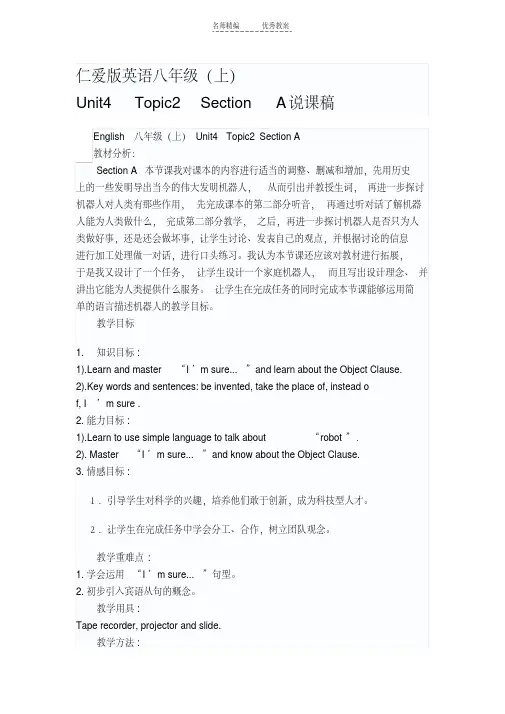
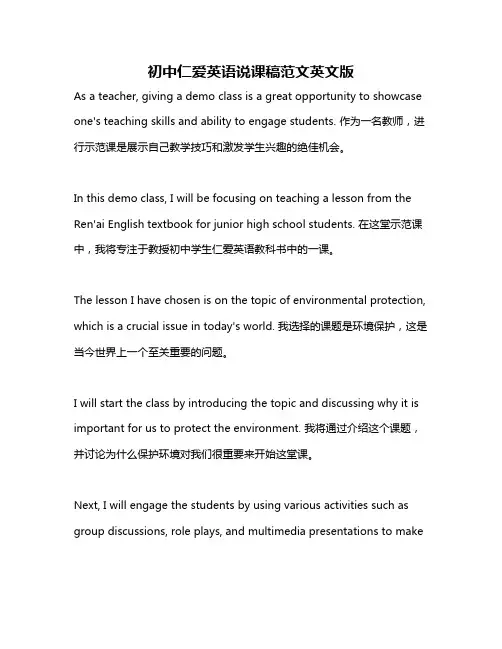
初中仁爱英语说课稿范文英文版As a teacher, giving a demo class is a great opportunity to showcase one's teaching skills and ability to engage students. 作为一名教师,进行示范课是展示自己教学技巧和激发学生兴趣的绝佳机会。
In this demo class, I will be focusing on teaching a lesson from the Ren'ai English textbook for junior high school students. 在这堂示范课中,我将专注于教授初中学生仁爱英语教科书中的一课。
The lesson I have chosen is on the topic of environmental protection, which is a crucial issue in today's world. 我选择的课题是环境保护,这是当今世界上一个至关重要的问题。
I will start the class by introducing the topic and discussing why it is important for us to protect the environment. 我将通过介绍这个课题,并讨论为什么保护环境对我们很重要来开始这堂课。
Next, I will engage the students by using various activities such as group discussions, role plays, and multimedia presentations to makethe lesson more interactive and fun. 接下来,我将通过使用各种活动,如小组讨论、角色扮演和多媒体展示来使课程更具互动性和趣味性。
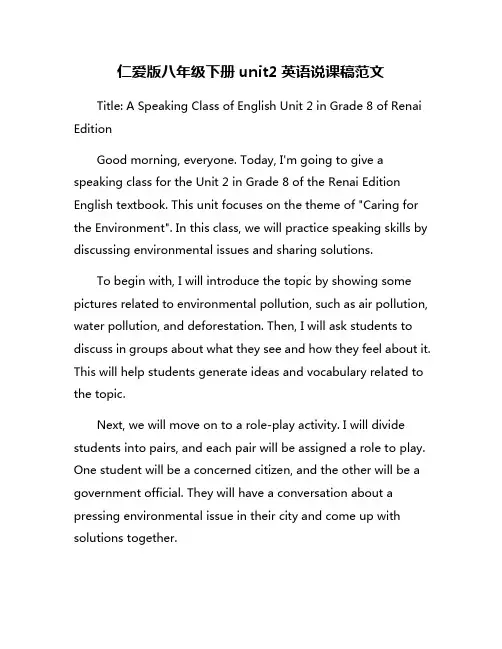
仁爱版八年级下册unit2英语说课稿范文Title: A Speaking Class of English Unit 2 in Grade 8 of Renai EditionGood morning, everyone. Today, I'm going to give a speaking class for the Unit 2 in Grade 8 of the Renai Edition English textbook. This unit focuses on the theme of "Caring for the Environment". In this class, we will practice speaking skills by discussing environmental issues and sharing solutions.To begin with, I will introduce the topic by showing some pictures related to environmental pollution, such as air pollution, water pollution, and deforestation. Then, I will ask students to discuss in groups about what they see and how they feel about it. This will help students generate ideas and vocabulary related to the topic.Next, we will move on to a role-play activity. I will divide students into pairs, and each pair will be assigned a role to play. One student will be a concerned citizen, and the other will be a government official. They will have a conversation about a pressing environmental issue in their city and come up with solutions together.After the role-play activity, we will have a whole-class discussion. I will ask students to share their ideas and solutions for the environmental issues they discussed. This will allow students to practice expressing their opinions and listening to others' viewpoints.To wrap up the class, I will assign students a homework task. They will need to research a local environmental issue and come up with a proposal for how to address it. In the next class, students will present their proposals to the class, practicing their speaking and presentation skills.In conclusion, this speaking class for Unit 2 of Grade 8 in the Renai Edition English textbook will provide students with valuable practice in discussing environmental issues and sharing solutions. By engaging in role-plays, group discussions, and presentations, students will improve their speaking skills and deepen their understanding of the importance of caring for the environment. Thank you for your attention, and let's get started!。
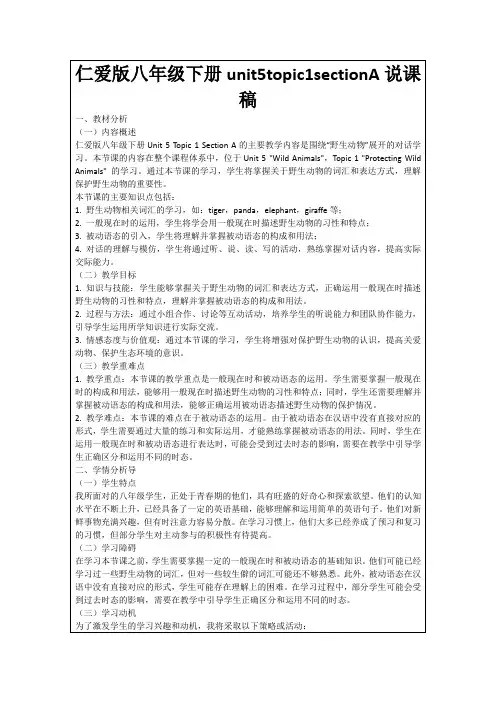
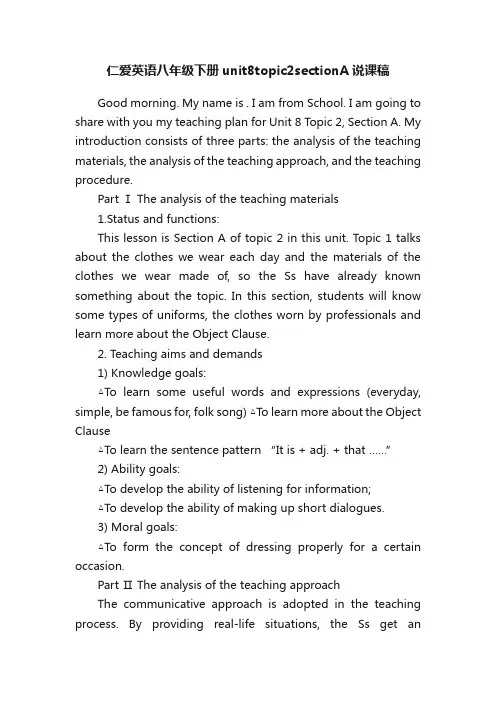
仁爱英语八年级下册unit8topic2sectionA说课稿Good morning. My name is . I am from School. I am going to share with you my teaching plan for Unit 8 T opic 2, Section A. My introduction consists of three parts: the analysis of the teaching materials, the analysis of the teaching approach, and the teaching procedure.Part Ⅰ The analysis of the teaching materials1.Status and functions:This lesson is Section A of topic 2 in this unit. Topic 1 talks about the clothes we wear each day and the materials of the clothes we wear made of, so the Ss have already known something about the topic. In this section, students will know some types of uniforms, the clothes worn by professionals and learn more about the Object Clause.2. Teaching aims and demands1) Knowledge goals:△To learn some useful words and expressions (everyday, simple, be famous for, folk song) △T o learn more about the Object Clause△To learn the sentence pattern “It is + adj. + that ……”2) Ability goals:△To develop the ability of listening for information;△To develop the ability of making up short dialogues.3) Moral goals:△To form the concept of dressing properly for a certain occasion.Part Ⅱ The analysis of the teaching approachThe communicative approach is adopted in the teaching process. By providing real-life situations, the Ss get anopportunity to apply what they are learning, which is the basic aim of any language teaching. The Ss not only learn about the language, but also learn to use the language in this class.In accordance with the notion of “learning through doing” and “learning through using”, enough chances to practice, such as pair work, group work are provided so that the Ss take an active part throughout the teaching process.Part III The analysis of the teaching procedureStep 1 Review (5’)Present the Ss with a picture of a coat, and ask the Ss to talk about the color, size and material of the coat. Then invite one student to talk about the clothes he wears and another student to decide whether it’s proper for the student to wear clothes like that, and then naturally lead to the topic of uniforms. Then present the Ss with more pictures of peoplewearing uniforms. Ask the Ss who usually wear each uniform and why they wear uniforms.Step 2 Presentation (8’)1.Listen to 1a and answer the following question: can Miss Wang allow her students to design their own uniforms?2.Listen to 1a again, and ask the Ss to mark the key words and phrases. Explain the usage of the key words and phrases.3. Ask the students to find out sentences with Object Clause.Step 3 Consolidation (15’)1. Ask the Ss to act out 1a with the help of the key words.2. Activity: what does he/she ask?Ask the students to study the example in 1b to make sure all the students know what they are expected to do. Divide the class into groups of three. One student asks a question, the second student asks the third student “what does he/she ask?”, andthe third student answers the question. Then they switch roles. This activity aims to practice the Object Clause beginning with wh- words. Invite one group to act out their dialogue in front of the class.3.Activity: what should he/she wear …?Now the students know that on different occasions, different kinds of clothes should be worn. List as much kinds of clothes as possible. Imagine six occasions, at the office, in winter, at home, on the Great Wall, in the park, on windy days. Ask the students what kind of clothes should people wear on those occasions. Divide the class into groups of two. Ask the students to make up dialogues following the example in 3 and act them out. Then invite some groups to act out their dialogue in front of the class.Step 4 Practice (12’)1. Listen to 2a and answer the question: when do the police wear uniforms?2. Read the dialogue and find out the reasons why the police wear uniforms when they are at work.3. Mark the key words, “suitable”, “find us easily”, “stop …from…”. Ask the students to repeat the policewoman’s answer with the help of the key words.Step 5 Project (5’)Divide the class into pair of three. Imagine one student is a doctor/teacher/soldier … The second student interviews his partner by asking “Is it important for you to wear uniforms at work?” The third student repeats the answer by saying “He/she says …”That’s all for my introduction. I sincerely welcome your suggestions. Thanks for your time.。

八年级仁爱英语说课稿范文Hello everyone, I am excited to have the opportunity to introduce a lesson from the eighth grade Renai English textbook today. 大家好,很高兴有机会今天给大家介绍一堂八年级仁爱英语课的内容。
In this lesson, we will be focusing on a reading passage about the importance of protecting endangered animals. 这节课我们将会重点阅读一篇关于保护濒危动物重要性的文章。
The passage discusses the various reasons why it is crucial to protect endangered animals, such as maintaining biodiversity and preserving the balance of ecosystems. 在这篇文章中,我们将了解到为什么保护濒危动物是至关重要的,比如保持生物多样性和维护生态系统的平衡。
Not only does protecting these animals benefit the environment, but it also plays a significant role in sustaining our own livelihoods. 不仅保护这些动物有益于环境,而且对维持我们自己的生计也起着重要作用。
Through this lesson, students will not only improve their reading comprehension skills but also gain a better understanding of theimportance of environmental conservation. 通过这堂课,学生们不仅可以提高他们的阅读理解能力,还可以更加深入地了解环保的重要性。
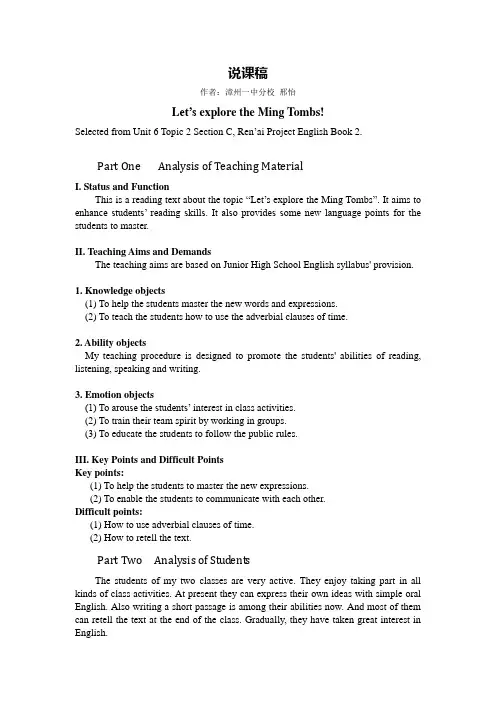
说课稿作者:漳州一中分校邢怡L et’s explore the Ming Tombs!Selected from Unit 6 Topic 2 Section C, Ren’ai Project English Book 2.Part One Analysis of Teaching MaterialI. Status and FunctionThis is a reading text about the topic “Let’s explore the Ming Tombs”. It aims to enhance students’ reading skills. It also provides some new language points for the students to master.II. Teaching Aims and DemandsThe teaching aims are based on Junior High School English syllabus' provision.1. Knowledge objects(1) To help the students master the new words and expressions.(2) To teach the students how to use the adverbial clauses of time.2. Ability objectsMy teaching procedure is designed to promote the students' abilities of reading, listening, speaking and writing.3. Emotion objects(1) To arouse the students’ interest in class activities.(2) To train their team spirit by working in groups.(3) To educate the students to follow the public rules.III. Key Points and Difficult PointsKey points:(1) To help the students to master the new expressions.(2) To enable the students to communicate with each other.Difficult points:(1) How to use adverbial clauses of time.(2) How to retell the text.Part Two Analysis of StudentsThe students of my two classes are very active. They enjoy taking part in all kinds of class activities. At present they can express their own ideas with simple oral English. Also writing a short passage is among their abilities now. And most of them can retell the text at the end of the class. Gradually, they have taken great interest in English.Part Three Analysis of Teaching Methods1. Audio-visual teaching method2. Task-based teaching method3. Free discussion methodPart Four Analysis of Learning Methods1.To take an active part in class activities.2.To summarize the language points through their own thinking.3.To make use of the new language material to express their own ideas.Part Five Analysis of Teaching ProcedureStep 1 Brain storming (3 minutes)Step 2 Digest the text (23 minutes)Step 3 Outline the story (5 minutes)Step 4 Discussion (3 minutes)Step 5 Additional materials (5 minutes)Step 6 Project (6 minutes)The six tasks are designed to follow the gradualism principle. Each task is harder than the former one.Step 1 Brain stormingThis task aims to help the students remember the new words.First, I will guide the students to read the new words according to the pronunciation rules.Second, I will ask the students to make up four short stories with the new words. And the main structure of the story will be given to make the task easy and interesting. The students just need to fill in the blanks with the right words to complete the story.The interesting stories will help the students to remember the new words quickly. And also this task can begin this lesson with exciting atmosphere.Step 2 Digest the TextHere I adopt four steps for the students to digest the text.1. Listening (3 minutes)The students are supposed to listen to the tape and get some main ideas about the text. Then I will ask the students to answer some simple yes-or-no questions to check their listening comprehension.2. Skipping and Scanning (5~6 minutes)After listening, students begin to read the text for the first time.First, they should underline the new expressions while reading.Second, they should number the pictures in the right order. They should finish this part by skipping and scanning.Third, I will explain the new expressions and ask the students to fill in the blankswith them. This exercise will make the new points more impressive.At last, some translation should be done here for the students to practice more.3. Grammar Focus (10 minutes)This is a difficult point in this lesson.First, I will pick out all the sentences with adverbial clauses of time from the text. And I will ask the students to find out all the conjunctions about time.Second, I will use examples to help the students summarize how to use these conjunctions by comparison. And in this way the students will go through the old grammar points with their own thinking.Then we will move on to the new points. I will help the students to master these new points with explicit illustration with examples.Third, I will show an abstract of the text with blanks. And the students should fill in the blanks with the right conjunctions. This exercise can help the students learn to make use of the former summary to distinguish the right conjunction from the other ones.At last, sentence making is employed here. So the students can practice how to use the adverbial clauses of time to consolidate what they have learnt.4. Intensive Reading (3~4minutes)Intensive reading helps to get details. So I design some questions about detail information to check the students' comprehension.Step 3 Outline the StoryIn this task, I design two activities:Activity 1. Use one sentence to sum up the main idea of each paragraph. It can help students to master the whole story. And it can also help them to go through Activity 2.Activity 2. Retell the story in your own words. Retelling the story demands the students' higher ability to organize the whole passage orally. And it needs their good understanding and good memory as well as good language ability. This activity is a challenge for the quick learners to improve themselves.Step 4 DiscussionAfter the former task, the students can master the whole story. To go further, I'd like to enlighten the students to think more about the text. And the discussion about the public rules will help me to achieve the emotion objects I mentioned.First, I will ask: Do you think the three boys' travel experience was pleasant? Why not? If you go traveling, should you do the following things? For example, should you wait in the queue? Should you push other people? The students will tell me yes or no.Second, I will let the students discuss and name some other public rules.Step 5 Additional MaterialsActivity 1. Listen More. This is Part 2 from this lesson. Here the students are supposed to get some detail information to fill in the blanks with.Activity 2. Read More. Here I select an interesting short story about traveling. Most of the new words are not translated. So the students will guess the meaning of these words while understanding the whole story. It can help the students to cultivate their language sense. And here is only one question to check their reading comprehension.Step 6 ProjectI will show some pictures first and tell students about my travel experience to arouse their interest. Then, I will ask them to write an e-mail to their friends to tell him or her about their own travel experience. At last, I will ask some students to read their compositions as examples for the class.In the end, I will show the assignment for the students to do at home.This is my design of the blackboard. All the useful expressions and grammar points are listed on the blackboard.Part 6 ReflectionIn the process of teaching, I carry on task-based teaching method. I design six tasks for the students to complete, and each task is harder than the former one. I try to make the lesson rich, effective, and instructive. But as we know, not all the students are of the same level, a few of them may have difficulty in Task 5-- retelling the story. However, every coin has two sides. If all the activities are designed for the average students, the quick learners will not improve their ability in such a class. I hope I can find out some multi-activities for students of different levels to solve this problem.。
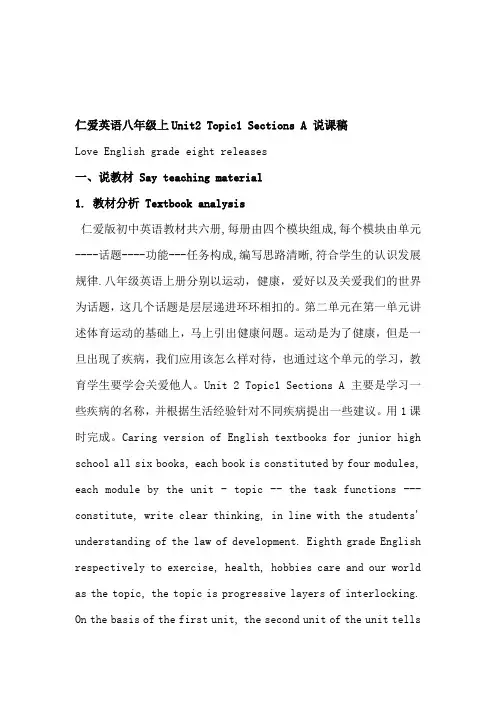
仁爱英语八年级上Unit2 Topic1 Sections A 说课稿Love English grade eight releases一、说教材 Say teaching material1. 教材分析 Textbook analysis仁爱版初中英语教材共六册,每册由四个模块组成,每个模块由单元----话题----功能---任务构成,编写思路清晰,符合学生的认识发展规律.八年级英语上册分别以运动,健康,爱好以及关爱我们的世界为话题,这几个话题是层层递进环环相扣的。
第二单元在第一单元讲述体育运动的基础上,马上引出健康问题。
运动是为了健康,但是一旦出现了疾病,我们应用该怎么样对待,也通过这个单元的学习,教育学生要学会关爱他人。
Unit 2 Topic1 Sections A 主要是学习一些疾病的名称,并根据生活经验针对不同疾病提出一些建议。
用1课时完成。
Caring version of English textbooks for junior high school all six books, each book is constituted by four modules, each module by the unit - topic -- the task functions --- constitute, write clear thinking, in line with the students' understanding of the law of development. Eighth grade English respectively to exercise, health, hobbies care and our world as the topic, the topic is progressive layers of interlocking. On the basis of the first unit, the second unit of the unit tellsthe health issues. Exercise is to be healthy, but once there is a disease, we should treat it, and through this unit of learning, education students should learn to care for others. Unit 2 Sections A Topic1 is mainly to learn the names of some diseases, and according to the life experience for different diseases put forward some suggestions. With 1 hours to complete.2.教学目标 Teaching target(1).知识目标 knowledge of the target要求学生牢记Section A 所有新学的四会单词.Students are required to remember all the new words Section A four短语和重点句型Phrases and key sentence patterns : have a cold/fever/cough/headache/flu/stomachache/toothache/backach e have sore eyes 并学会使用(And learn to use ) You should/shouldn’t 和You’d better 提建议Suggestion。
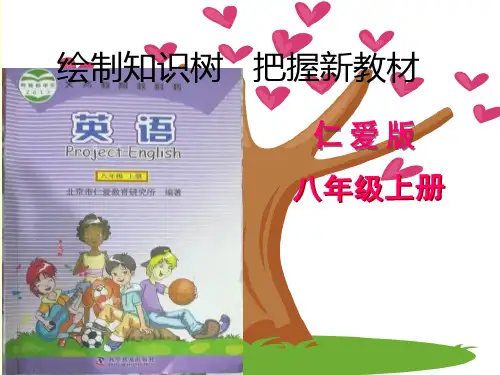
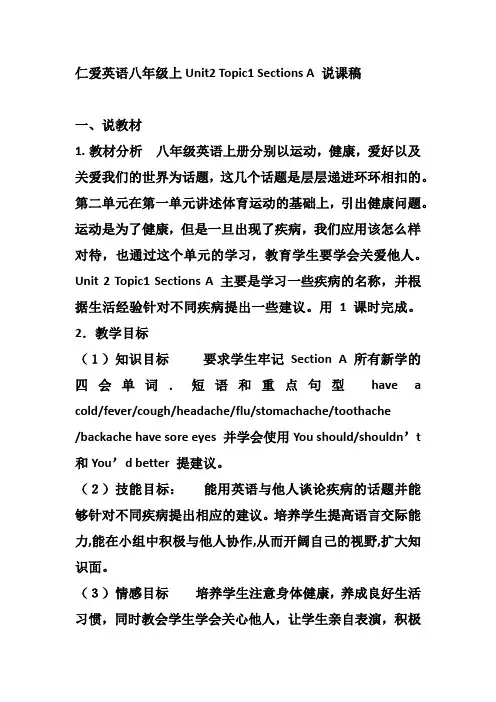
仁爱英语八年级上Unit2 Topic1 Sections A 说课稿一、说教材1.教材分析八年级英语上册分别以运动,健康,爱好以及关爱我们的世界为话题,这几个话题是层层递进环环相扣的。
第二单元在第一单元讲述体育运动的基础上,引出健康问题。
运动是为了健康,但是一旦出现了疾病,我们应用该怎么样对待,也通过这个单元的学习,教育学生要学会关爱他人。
Unit 2 Topic1 Sections A 主要是学习一些疾病的名称,并根据生活经验针对不同疾病提出一些建议。
用1课时完成。
2.教学目标(1)知识目标要求学生牢记Section A 所有新学的四会单词.短语和重点句型have a cold/fever/cough/headache/flu/stomachache/toothache/backache have sore eyes 并学会使用You should/shouldn’t 和You’d better 提建议。
(2)技能目标:能用英语与他人谈论疾病的话题并能够针对不同疾病提出相应的建议。
培养学生提高语言交际能力,能在小组中积极与他人协作,从而开阔自己的视野,扩大知识面。
(3)情感目标培养学生注意身体健康,养成良好生活习惯,同时教会学生学会关心他人,让学生亲自表演,积极参与课堂上各种英语实践活动的兴趣。
培养学生分工合作和团体协作精神。
3.教学重点和难点(1).重点:谈论疾病have a …提建议You should /You’d better(2).难点:根据不同的疾病提出相应的建议二.说学情 1.学生肯定对于这部分知识感兴趣,而且接近生活,学生会有很多要说的话,会积极参与。
2.本届学生基础较差,学生的词汇量掌握不多。
尽量教会学生表达自己的意思。
3. 学生平时较少用英语与他人交谈并表达信息.。
利用他们对知识的兴趣,教会他们更多知识。
三.说教法学法按照课程改革的要求,遵循“老师由主演变导演,学生由配角变主角”的角色转换,采用把课堂交给学生的教学理论,我运用自主学习,结对练习,合作探究,亲自参与模仿表演各种疾病并表演医生或朋友提建议等方法,借助多媒体、录音机,图片等教学手段,设置特定的语言环境,使学生在轻松愉快的气氛中理解.运用英语。
仁爱英语八年级上册说课稿Unit 1 Topic 2 Section D
说课稿
仁爱英语八年级(上)Unit1Topic2SectionD说课稿
各位评委,老师好!
今天我说课的内容是初中英语教材仁爱版八年级上Unit1Topic2SectionD下面我
将从以下几个方面阐述说课内容。
一.说教材
(一)本课在教材中的地位和作用
仁爱版初中英语教材中的每个模块由单元----话题----功能---任务构成,编写思路清晰,符合学生的认识发展规律.我说课的课题是仁爱英语第八册(上),Unit1Topic2SectionD,本课是本单元的第二个话题的第四课时,这个话题的主要内容就是学习
makingrequestsandresponses,theSimpleFutureTense,somenewwordsandusefulexpre ssions.通常在第四个section中都会总结前三个section的语法及交际用语
所以说这节课对于这个话题的巩固起着至关重要的作用.
(二).教学目标与要求
根据课标“巩固,扩大学生的基础知识”和关于词汇方面的要求,以。
Ⅰ. Teaching aims and demands
1.Learn some useful words and expressions:
the People’s Republic of China, winner, grass, visitor, improve,
environment, ourselves
2.Learn “There be” sentence pattern in the Simple Future Tense:
(1)There will be more roads.
(2)There will be more subways. ect.
3.Talk about the Olympic games:
(1)The People’s Republic of China took part in the Olympics for the first
time in 1952.
(2)Some information about the Olympics Beijing has taken part in.
(3)Beijing will host the 29th Olympic Games in the year 2008.
4.Review the Simple Past Tense and the Simple Future Tense:
(1)China won 28 gold medals in the 2000 Sydney Olympics…
(2)Beijing will host the 2008 Olympic Games.
(3)How old will you be in 2008?
(4)What should we do for the Beijing Olympics in 2008?
II. Teaching Procedure:
1.Warming-up
Talk about the sports we’ve learnt by showing the pictures of the five
mascots, using the simple future tense. For example:
A: What will you do this afternoon?
B: I will play basketball.
Have a discussion on what the mascots stand for. The teacher introduce
some information about the mascots. “Beibei, Jingjing, Huanhuan, Yingying,
Nini” stands for “Welcome to Beiing.”
2.leading-in
Show the new words and phrases by talking something about the Olympics.
T: Beijing will host the 2008 Olympics. This is the very first time for the
People’s Republic of China to host it. As we know, China took park in the
Olympics long time ago. We took part in the Los Angeles Olympics, we took
part in the Sydney Olympics and we took part in the Athens Olympics.We’ve
won many gold medals in history. And if you want to get the gold medals you
should be thewinner.
List and read the new words and phrases.
3.Read and understand.
1).Listen and read the passage in the flash for the first time, trying to
answer one question: Which Olympics will Beijing host in 2008 ?
2).Read the passage on the books for the second time. And try to do the true
or false questions alone.
3).Read the passage for the third time. Work with the partner, and try to fill
the chart.
WhenWhereWhat
1952
China took part in for the 1st time
Los Angeles
China won 28 gold medals
2004
China will host the 29th Olympics
4).Help the students retell the passage according to the information in the
chart.
5). Read aloud the passage after the teacher.
4. Practice